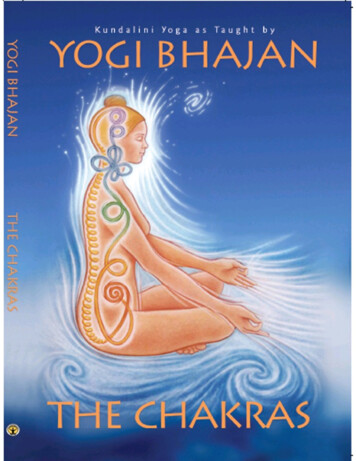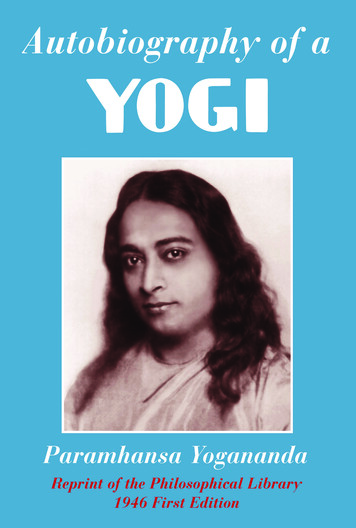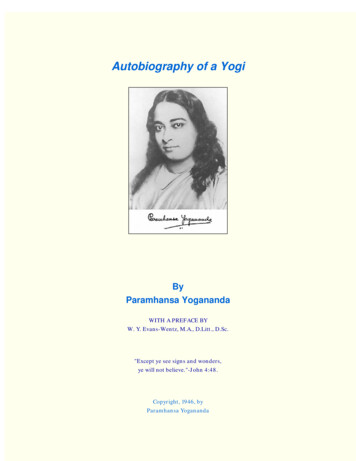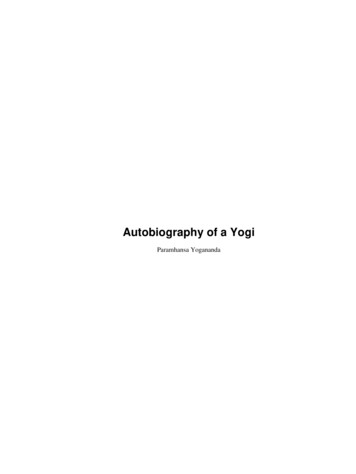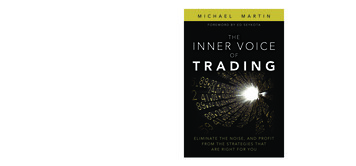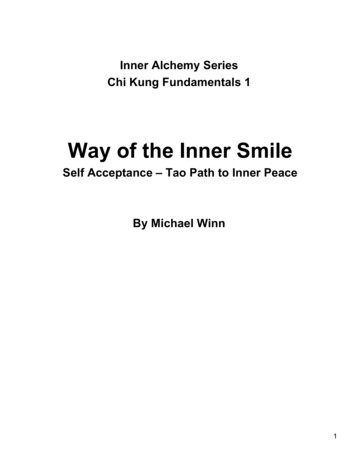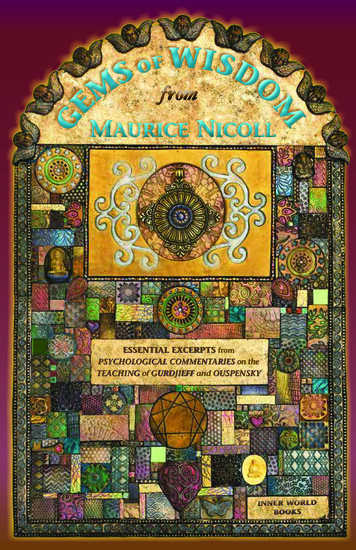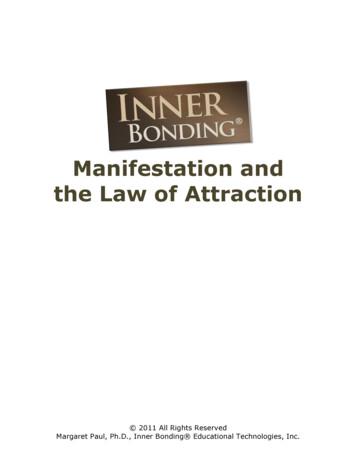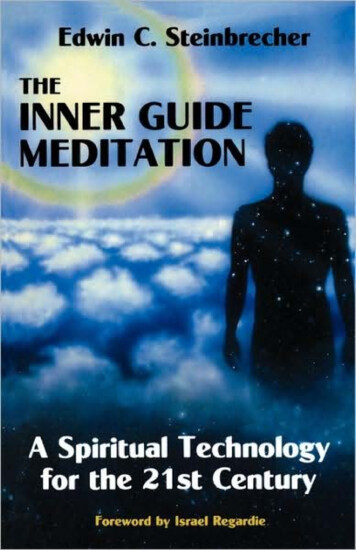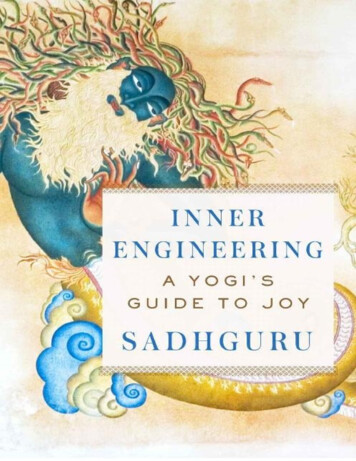
Transcription
This is a work of nonfiction. Some names and identifying details have been changed.Copyright 2016 by Jaggi VasudevAll rights reserved.Published in the United States by Spiegel & Grau, an imprint of Random House, a division of Penguin Random House LLC, New York.SPIEGEL & GRAU and Design is registered trademark of Penguin Random House LLC.Grateful acknowledgment is made to Penguin UK, a Penguin Random House Company, for permission to reprint an excerpt from SPEAKINGOF SIVA, translated with an introduction by A. K. Ramanujan (Penguin Classics, 1973). Copyright 1973 by A. K. Ramanujan. Reprinted bypermissionLIBRARY OF CONGRESS CATALOGING-IN-PUBLICATION DATANames: Vasudev, Jaggi, Sadhguru, author.Title: Inner engineering : a Yogi’s guide to joy / Sadhguru.Description: First Edition. New York : Spiegel & Grau, 2016.Identifiers: LCCN 2015048462 ISBN 9780812997798 ISBN 9780812997804 (ebook)Subjects: LCSH: Yoga. Spiritual life.Classification: LCC BL1238.54 .V37 2016 DDC 204/.36—dc23 LC record available at https://lccn.loc.gov/2015048462ebook ISBN mBook design by Dana Leigh Blanchette, adapted for ebookTitle-page art spread: Artwork from Isha Yoga Center, Coimbatore, IndiaTitle-page and part-title ornament: iStockphoto.comPart-title art: il67/ShutterstockCover design: Greg MollicaCover art: courtesy of Isha Yoga Center, Coimbatore, Indiav4.1 r1ep
ContentsCoverTitle PageCopyrightEpigraphThe Four-Letter WordPart OneA Note to the ReaderWhen I Lost My SenseThe Way Out Is InDesign Your DestinyNo Boundary, No Burden“. . . And Now, Yoga”Part TwoA Note to the ReaderBodyMindEnergyJoyGlossaryInner Engineering Online ProgramAbout the Author
One man’s “magic” is another man’s engineering.—ROBERT A. HEINLEIN
The Four-Letter WordOnce it happened A customer walking into Shankaran Pillai’s pharmacy saw a man outside hugging alamppost, his eyeballs rolling wildly.When he walked in, he asked, “Who’s that man? What’s wrong with him?”Shankaran Pillai replied, unperturbed, “Oh, that guy. He’s one of my customers.”“But what’s the matter with him?”“He wanted something for a whooping cough. I gave him the appropriate medicine.”“What did you give him?”“A box of laxatives. I made him take it right here.”“Laxatives for a whooping cough! Why on earth would you give him that?”“Oh come on, you saw him. You think he dares to cough anymore?”Shankaran Pillai’s box of laxatives is emblematic of the type of solution being peddled all over theworld today for those in search of well-being. It is the fundamental reason the term “guru” has become afour-letter word.Unfortunately, we have forgotten the real meaning of the word. “Guru” literally means “dispeller ofdarkness.” The function of the guru, contrary to popular belief, is not to teach, indoctrinate, or convert.The guru is here to throw light on dimensions beyond your sensory perceptions and your psychologicaldrama, dimensions that you are currently unable to perceive. The guru is here, fundamentally, to throwlight on the very nature of your existence.There are many spurious and dangerously misleading teachings in vogue in our world today. “Be in themoment” is one of them. The assumption is that you could be somewhere else, if you wanted. How is thateven possible? The present is the only place that you can be. If you live, you live in this moment. If youdie, you die in this moment. This moment is eternity. How are you going to escape it, even if you try?Right now your problem is that you suffer what happened ten years ago and you suffer what may happenthe day after tomorrow. Both are not living truths. They are simply a play of your memory andimagination. Does this mean then that in order to find peace you must annihilate your mind? Not at all. Itsimply means you need to take charge of it. Your mind carries the enormous reserves of memory and theincredible possibilities of the imagination that are the result of an evolutionary process of millions ofyears. If you can use it when you want and put it aside when you don’t, the mind can be a fantastic tool. Toshun the past and neglect the future is to trivialize this wonderful faculty. So “be in the moment” becomesa crippling psychological restriction—it denies our existential reality.“Do only one thing at a time” has become another popular self-help slogan. Why would you do onlyone thing when the mind is a phenomenal multidimensional machine, capable of handling several levels ofactivity all at once? Instead of harnessing and learning to ride the mind, why would you want to obliterate
it? When you can know the heady joy of mental action, why would you opt for a lobotomy, for voluntarycabbage-hood?The other phrase that has hardened into cliché through overuse is “positive thinking.” When it isoversimplified and used as some quick-fix mantra, positive thinking becomes a way of whitewashing orsugarcoating your reality. When you are unable to process real-time information and control yourpsychological drama, you seize on “positive thinking” as a tranquilizer. Initially, it might seem to imbueyour life with new confidence and optimism. But it is essentially limited. In the long term, if you deny oramputate one part of reality, it gives you a lopsided perspective of life.Then there is the time-honored business of exporting human well-being to the heavens and claiming thatthe core of the universe is love. Love is a human possibility. If you need a refresher course, you can takelessons from your dog. He is full of love! You don’t have to go to outer space to know love. All thesepuerile philosophies come from the assumption that existence is human-centric. This single idea hasrobbed us of all sense and made us commit some of the most inhuman and heinous crimes throughouthistory. These continue to perpetuate themselves to this very day.As a guru, I have no doctrine to teach, no philosophy to impart, no belief to propagate. And that isbecause the only solution for all the ills that plague humanity is self-transformation. Self-transformation isnot incremental self-improvement. Self-transformation is achieved not by morals or ethics or attitudinal orbehavioral changes, but by experiencing the limitless nature of who we are. Self-transformation meansnothing of the old remains. It is a dimensional shift in the way you perceive and experience life.Knowing this is yoga. One who embodies this is a yogi. One who guides you in this direction is a guru.My aim in this book is to help make joy your constant companion. To make that happen, this book offersyou not a sermon, but a science; not a teaching, but a technology; not a precept, but a path. It is now timeto start exploring that science, working the technology, walking the path.On this journey, the guru is not the destination but the road map. The inner dimension is unchartedterrain. If you are exploring terrain that is unfamiliar to you, isn’t it better to have signposts? You couldfind your own way, but who knows, it could take lifetimes. When you’re on unfamiliar terrain, it’s justsensible to take directions. On one level, that is all a guru is—a live road map. GPS: Guru PathfindingSystem!And that’s why there exists that infamous four-letter word.Just to make things doubly easy for you, I thought I’d make it eight Sadhguru
A Note to the ReaderThere are many ways to approach a book of this kind. One way would be to plunge directly into practice,to take a headlong dive into do-it-yourself mode. But then this book doesn’t claim to be a self-helpmanual. It has a strong practical orientation, but there’s more to it than that.Another way would be to turn theoretical. But this book is not an exercise in scholarship either. I havenever read any of the yogic treatises in their entirety. I never had to. I come from inner experience. It wasonly late in my life when I skimmed through some of Patanjali’s Yoga Sutras, those significant yogic texts,that I realized that I had a certain access to their inner core. This is because I approach themexperientially, rather than theoretically. To reduce a sophisticated science, like yoga, to mere doctrine isjust as tragic as turning it into a cardiovascular workout.And so, this book has finally been divided into two sections. The first maps the terrain; the secondoffers you a way to navigate it.What you are about to read in this section is not a display of academic expertise. Instead, this sectionseeks to offer a series of fundamental insights—insights that lay the foundation or bedrock on which thearchitecture of the more practice-oriented second section is built.These insights are not tenets or teachings. And they are most definitely not conclusions. They are bestseen as signposts on a journey that can be made by no one but you. They are core perspectives that haveemerged as a consequence of the state of heightened awareness that has been mine since a lifetransforming experience thirty-three years ago.The section begins on an autobiographical note. This is so you know something about the authorialcompany you will be keeping, should you choose to read the rest of the book! The section then unfoldsinto an examination of certain basic ideas, exploring along the way some commonly used (and misused)terms such as destiny, responsibility, well-being, and even more fundamentally, yoga.One of the chapters in this section closes with a sadhana. The word “sadhana” in Sanskrit means adevice or a tool. These tools for exploration offer a chance for you as a reader to put the ideas discussedin those pages into action and see if the insights work for you. (These sadhanas will recur much morefrequently in Section Two.)I am often told by people that I seem to be a “modern” guru. My response to that observation is that Iam neither modern nor ancient, neither new age nor old age. I am contemporary, and that is how everyguru has always been. Only scholars, pundits, and theologians are capable of being ancient or modern. Aphilosophy or belief system can be old or new. But gurus are always contemporary.A guru, as I said earlier, is someone who dispels darkness, someone who opens the door for you. If Ipromise to open a door for you tomorrow or I opened it for someone else yesterday, it is of no relevance.Only if I open a door for you today is it of some value.So, the truth is timeless, but the technology and the language are always contemporary. If they weren’t,they would deserve to be discarded. No tradition, however time-honored, deserves to live on as anythingmore than a museum piece if it has outlived its relevance. So, while I will be exploring an ancienttechnology in this book, it is also a technology that is flawlessly state-of-the-art.
Personally, I am not interested in offering anything new. I am only interested in what is true. But I hopethat the following section will offer you some moments when the two converge. For at those junctureswhen the conditions are right—when an insight is articulated from a place of inner clarity and when itmeets a reader at the right moment of receptivity, an age-old truth turns explosively alchemical. All of asudden, it is fresh, alive, radiantly new, as if uttered and heard for the very first time in history.
Then I was a manI only went up the HillAs I had time to killBut kill I did all that wasMe and MineWith Me and Mine goneLost all my will and skillHere I am, an empty vesselEnslaved to the Divine Willand infinite skillIn the city of Mysore, there is a tradition. If you have something to do, you go up Chamundi Hill. And ifyou have nothing to do, you go up Chamundi Hill. If you fall in love, you go up Chamundi Hill. And if youfall out of love, you have to go up Chamundi Hill.One afternoon, I had nothing to do, and I had recently fallen out of love, so I went up Chamundi Hill.I parked my motorcycle and sat on an outcrop of rock about two-thirds of the way uphill. This was my“contemplation rock.” It had been for some time now. A purple berry tree and a stunted banyan had putdown tenacious roots into a deep fissure in the rock surface. A panoramic view of the city unfoldedbefore me.Until that moment, in my experience, my body and mind was “me” and the world was “out there.” Butsuddenly I did not know what was me and what was not me. My eyes were still open. But the air that Iwas breathing, the rock on which I was sitting, the very atmosphere around, everything had become me. Iwas everything that was. I was conscious, but I had lost my senses. The discriminatory nature of thesenses simply did not exist anymore. The more I say, the crazier it will sound because what washappening was indescribable. What was me was literally everywhere. Everything was exploding beyonddefined boundaries; everything was exploding into everything else. It was a dimensionless unity ofabsolute perfection.My life is just that moment, gracefully enduring.When I returned to my normal senses, it felt as if just ten minutes had elapsed. But a glance at my watchtold me that it was seven thirty in the evening! Four and a half hours had passed. My eyes were open, thesun had set, and it was dark. I was fully aware, but what I had considered to be myself until that moment
had completely disappeared.I have never been the teary kind. And yet, here I was, at the age of twenty-five, on a rock on ChamundiHill, so ecstatically crazy that the tears were flowing and my entire shirt was wet!Being peaceful and happy had never been an issue for me. I had lived my life the way I wanted. I hadgrown up in the sixties, the era of the Beatles and blue jeans, read my share of European philosophy andliterature—Dostoyevsky, Camus, Kafka, and the like. But here I was exploding into a completely differentdimension of existence of which I knew nothing, drenched in a completely new feeling—an exuberance, ablissfulness—that I had never known or imagined possible. When I applied my skeptical mind to this, theonly thing my mind could tell me was
A Note to the Reader There are many ways to approach a book of this kind. One way would be to plunge directly into practice, to take a headlong dive into do-it-yourself mode.
